A Humble Man and the Scarlet Ibis
We were in Trinidad to “bird.” Yes, the verb of the word bird: to look for birds. It was our last vacation before the coronavirus pandemic. Trinidad is an independent republic and the southernmost island in the Caribbean Sea, lying just seven miles off Venezuela’s coast. It is one of the best birding venues in this part of the world. And one of the most famous birding destinations on the island is the Caroni Swamp, a 12,000-acre bird sanctuary on the west side of the island just south of San Juan.

The swamp is the home of the national bird of Trinidad—the Scarlet Ibis. I’d never seen one, and it was on my bucket list. We were scheduled for a tour of the swamp with Nanan Bird Tours at 4 p.m.
Bill was driving our rental car. We were a bit anxious about driving because in Trinidad they drive on the left side of the road. I was riding shotgun and navigating with both GPS and a real map. Our wives, Gaye and Jeanne, were in the back. We were on pins and needles as Bill navigated our car through the irrational movements and excessive speed of the locals. We were told if we could survive the traffic here, we could drive anywhere in the world.
The entrance to the swamp was a somewhat hidden turnoff from the Uriah Butler Highway. Once we turned onto the dirt road, we stopped, caught our breath, and wondered whether we were in the right place. It was a low-lying, swampy, mosquito-infested area, and not a soul was around.
Down the Long Dirt Road in the Swamp
We drove slowly, very slowly, down a long, narrow half-gravel, half-dirt road parallel to a channel dug out of the swamp.
Jeanne gave me that look—the one that says, “I can’t believe you are dragging me into this place.”
About a half mile into the lowland, we saw a big, tall man near an old boat dock. As we approached, he looked up and walked toward us. Bill lowered his window saying we were looking for the Nanan Tour Boat. The big man pointed to a small grassy area and instructed us to park there. There, we suited up in our birding gear and sprayed ourselves with insect repellent.
Arrived!
We were the only tourists there because we were early as usual. Jeanne shot me another look. Across the gravel road were an old wooden pavilion and a dock with several small wooden boats tied up alongside.
American Birding Tourists
Bill and I headed to the relatively primitive toilets. The same big man was mopping the floor.
Our appearance was far beyond just the typical American tourist. We were birders with long-billed hats, pants tucked into our socks, long-sleeved shirts with pockets everywhere, fanny packs, binoculars, and cameras.
As the big man mopped the floor back and forth, he asked us what birds we were looking for. Bill rattled off a few bird names. The caretaker stopped mopping the floor and told us where we could find the birds. He pointed down the gravel road and said, “You’ll find the birds just past that billboard.”
Bill and I walked down the gravel road for about 20 minutes but didn’t find the birds. We returned to the dock to join people that had shown up for the tour of the swamp.
Front Seat on the Roller Coaster
It turns out the guy mopping the floor was also our boat captain and birding guide for the swamp tour. He pointed to Jeanne and then pointed to the front seat of an old green flat-bottomed wooden boat. He helped her and then me into the boat. I was so excited! Front seat! I had the same feeling in my youth, getting into the front seat of a roller coaster.
Bill and Gaye were seated directly behind us, and then birders from Britain (twitchers) filled the remaining seats.
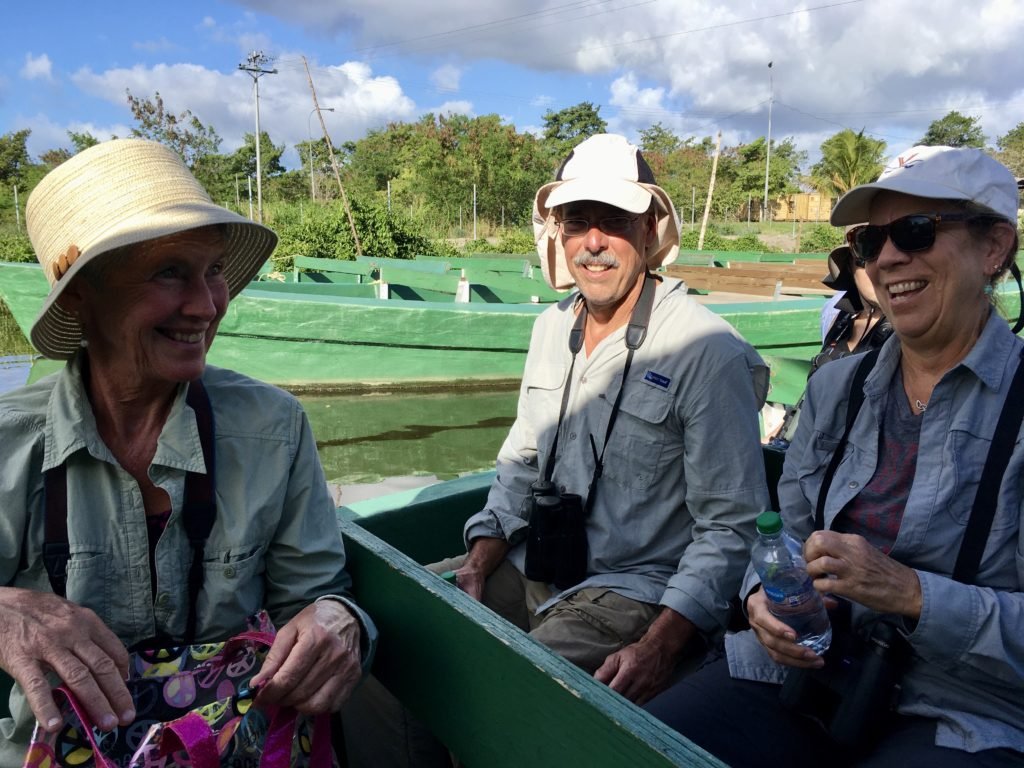
We motored slowly down a narrow canal, winding our way through the mangrove swamp parallel to the gravel road Bill and I had walked looking for birds. Our guide stopped the boat to show us birds. He could pick out birds without binoculars—a Peregrine Falcon, Tropical Screech Owls, Blue-Winged Mangos.
At one point, the guide said, “Guys, there’s a Pygmy Kingfisher right over there.” I couldn’t believe he could see it! It’s a five-inch bird! Bill and I had just walked past all these birds, but we never saw them.
Our guide had a special little flashlight with a green laser-light pointer. He pointed it just below the bird to help us locate it.
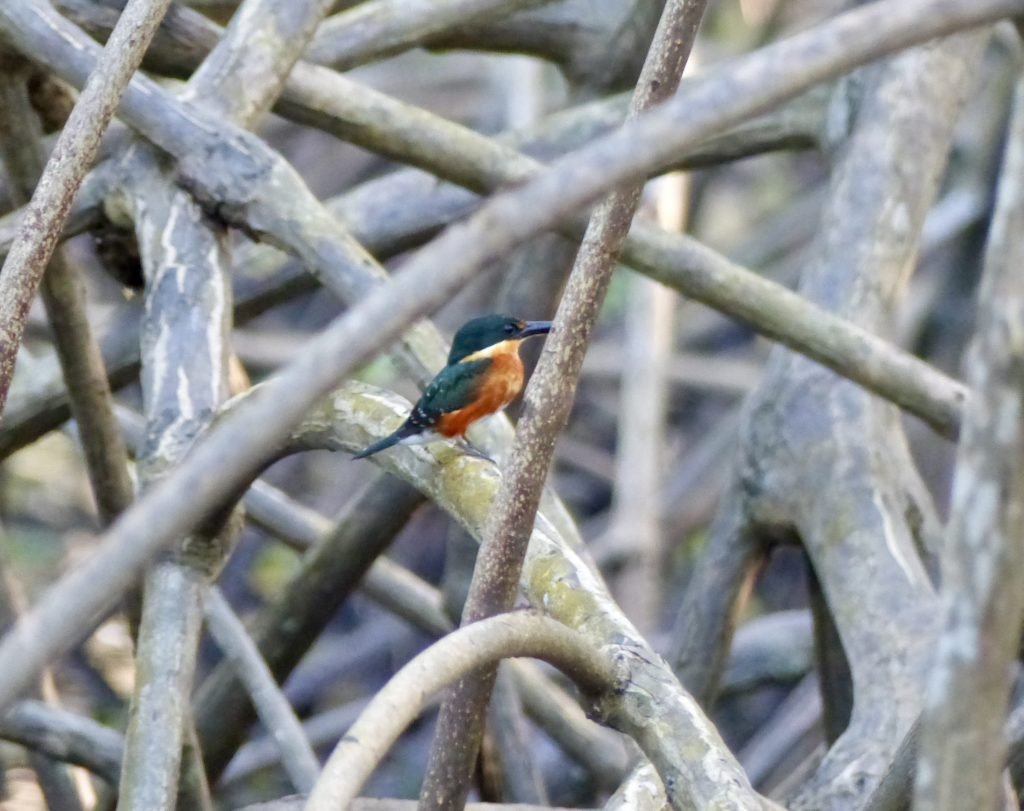
A Scarlet Ibis Flyover
After about an hour of excellent birding and wildlife viewing, our guide saw a Scarlet Ibis fly over, and he said we were going immediately to the roosting site. The outboard motor revved, and we glided smoothly through canals out into the open water of the swamp. The speed made a nice breeze on my skin, and the pink sky from the setting sun was so beautiful. Within a few minutes, we came in view of the island where the iconic Scarlet Ibis roosting takes place. There, feeding in the shallow waters on the north end of the island, were several hundred Pink Flamingos.
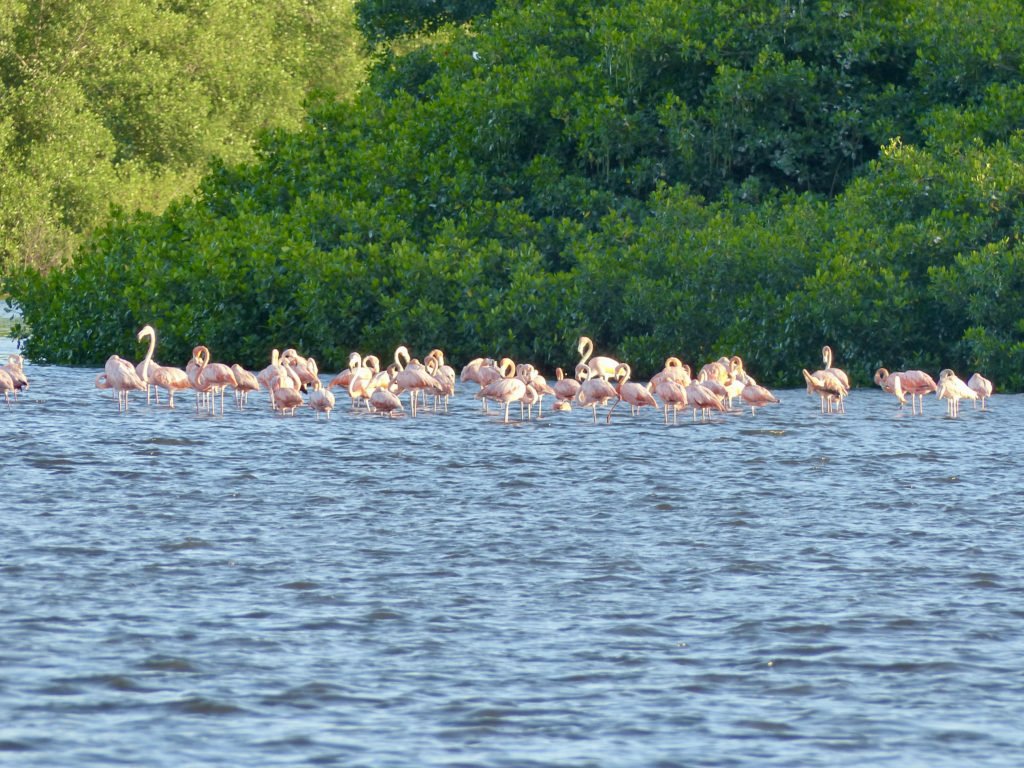
We pulled up to a skinny stick poking out of the water, tied our boat to it, and settled in for the show. The birding guide from the twitcher group brought out a gallon jug full of rum punch and passed out cups of the potion to all the passengers.
Quite a moment, the setting sun, Scarlet Ibises gliding in—I could hear the wind from their wings overhead. The only human noise was from people gasping at the sight. Ahh, a sip of rum punch. For a birder, it doesn’t get any better than this.
The Scarlet Ibises glided in by groups of 10 to 100, until there were thousands roosting on the island’s dark green vegetation.
Scarlet Ibis Island
The birds are bright scarlet-red. Their body is about the size of a football with a long neck and an equally long down-curved bill. It’s an unmistakable bird. On this island in the middle of the swamp they roost by the thousands, some say as many as 30,000.
Great Egrets, Snowy Egrets, Little Blue Herons, and other roosting birds added to the show, but the Scarlet Ibises stole it: The island looked like a Christmas tree overloaded with red lights. By the time the birds were in for the night, the island was as red as it was green. The twitchers passed out a second round of rum punch.
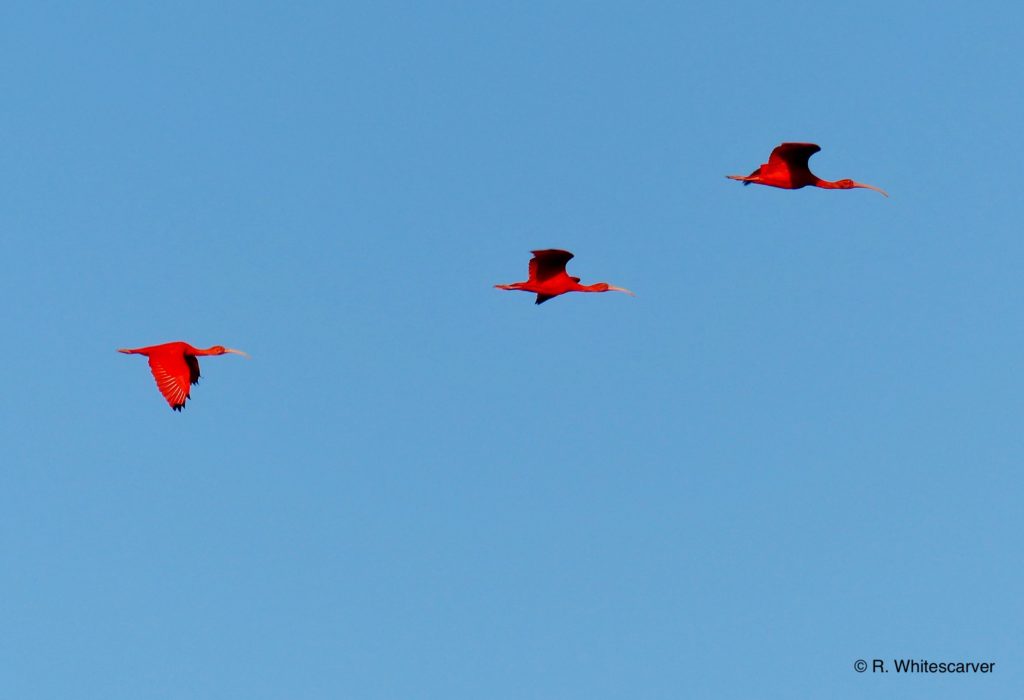
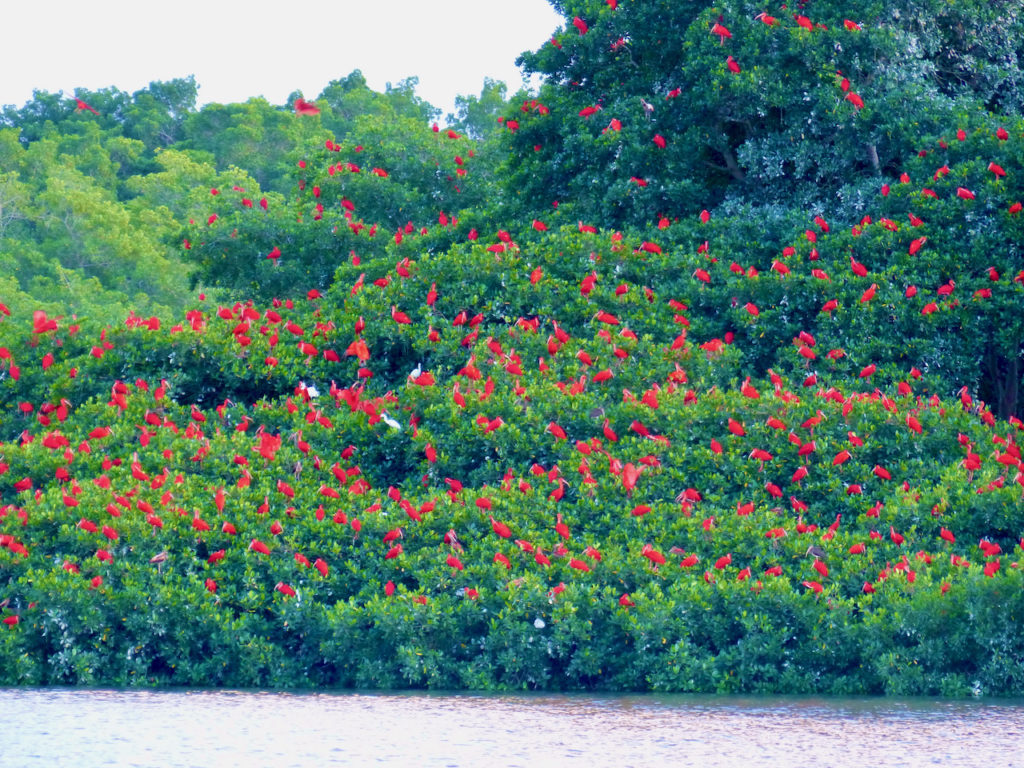
Our guide let us enjoy the phenomenon until almost dark, and then he started the motor and headed for the dock.
It turns out our guide was Lester Nanan, son of the late Winston Nanan, the champion of the Caroni Swamp. The man who saved the swamp from development, led the nation to protect the Scarlet Ibis, and declare it the national bird of Trinidad. He wrote, “If you save your own backyard then you begin to save the world.” Winston died in 2015.
The Humble Man
It was quite an honor to have Winston’s son as our guide—a sterling example of a humble man. He owns the company and mops the bathroom floor. He shares his love of birds and the swamp with total strangers and even geeky American tourists.
This was one of the most spectacular birding events in my life. And the rum punch wasn’t too bad either.
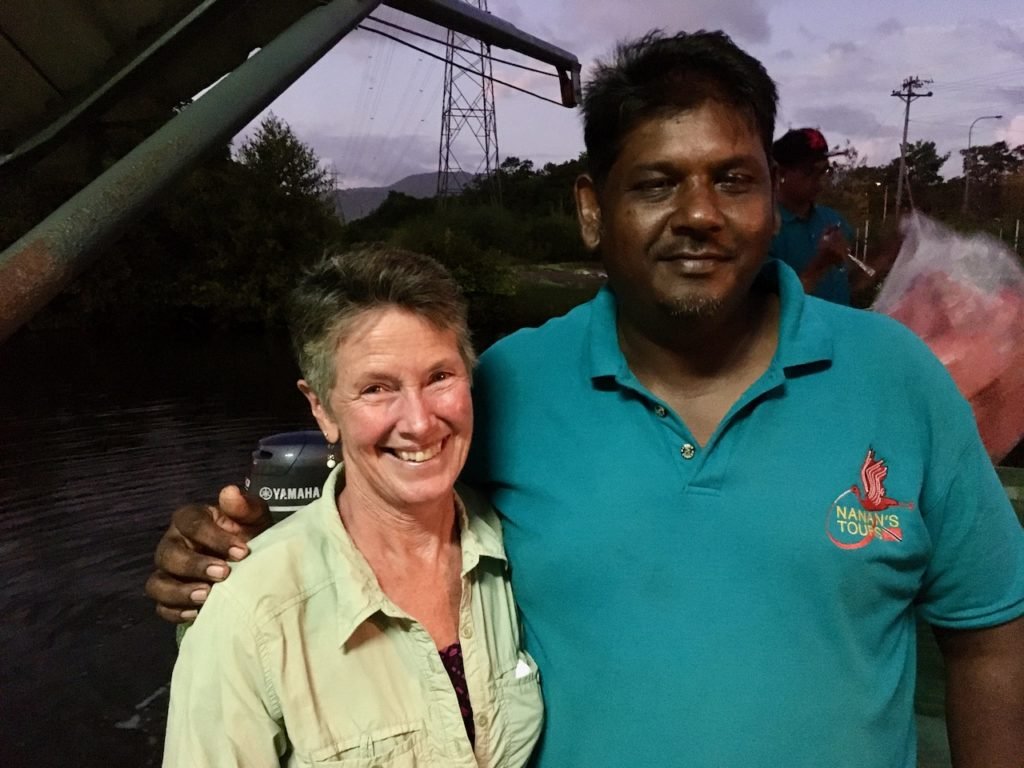
The post A Humble Man and the Scarlet Ibis appeared first on Getting More on the Ground.

